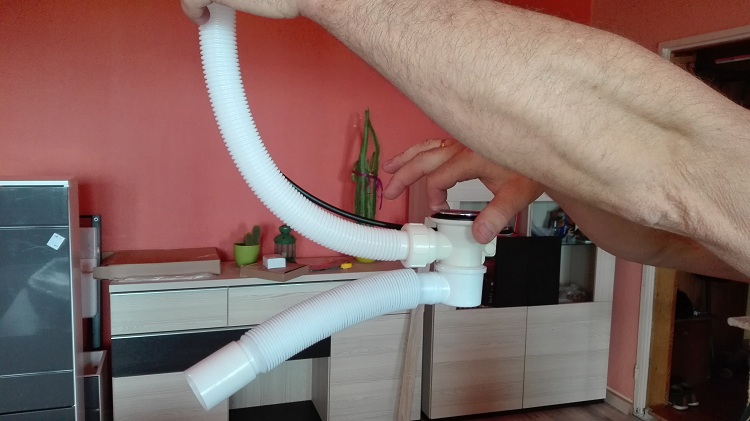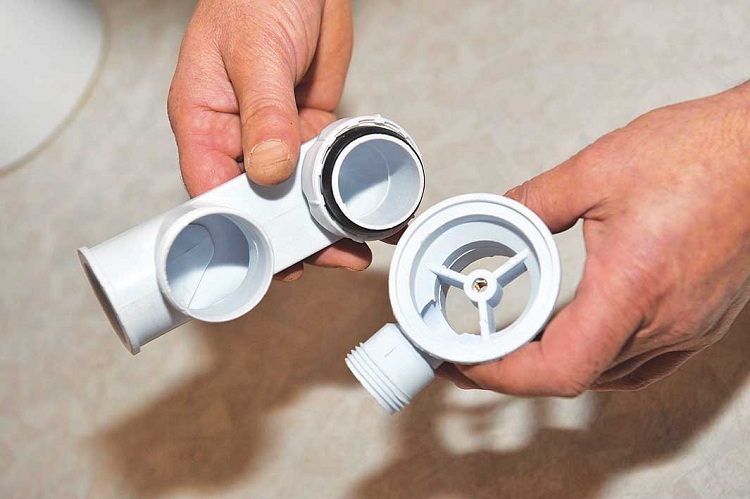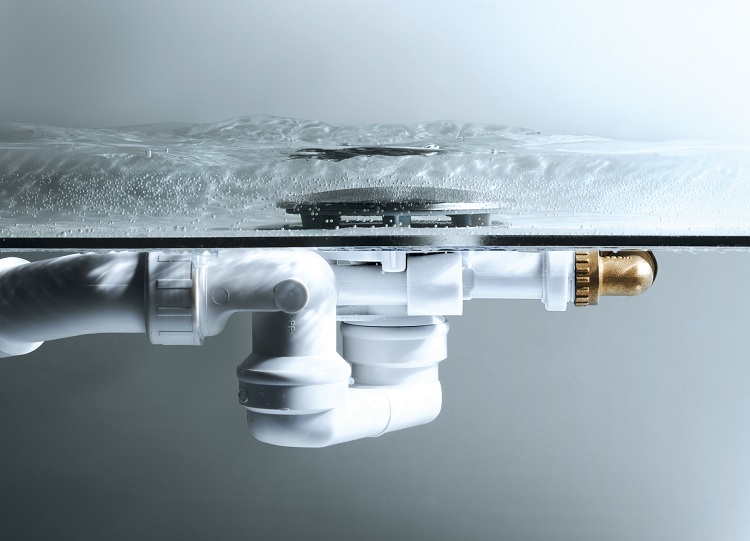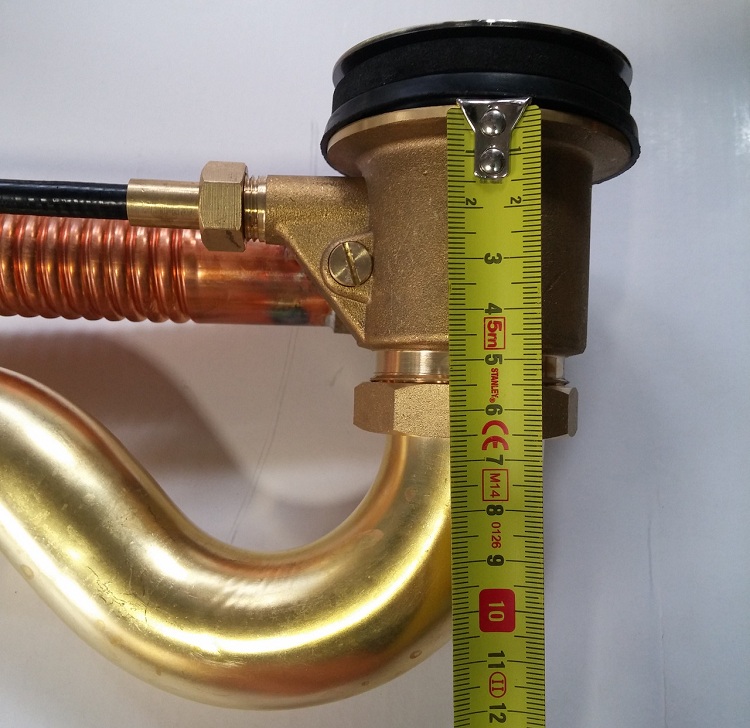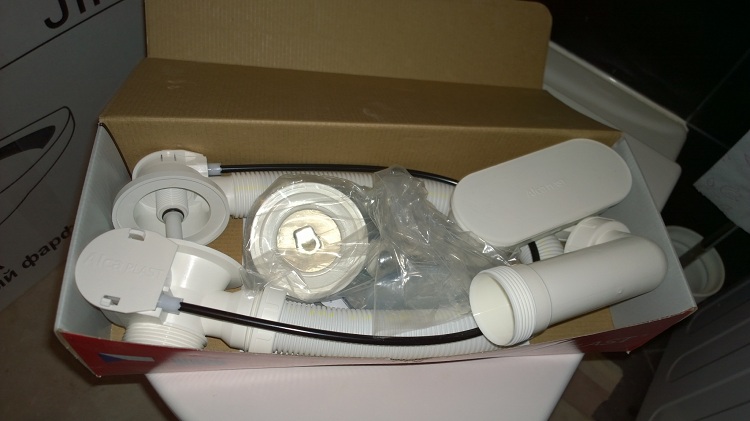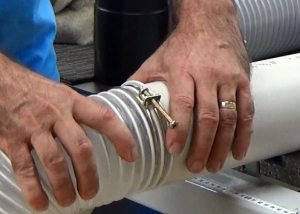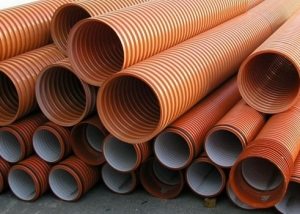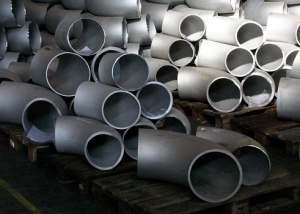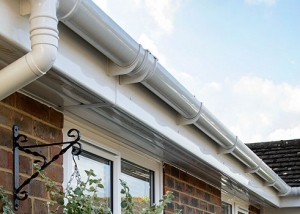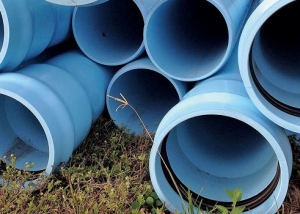A bath siphon is a device that is used to dock a plumbing fixture with a sewer network. From a structural point of view, such a siphon is somewhat more complicated than devices for connecting other sanitary devices. To date, there are several varieties of this device. In order to select the siphon necessary for a particular case, it is recommended to study all their types and differences of each.
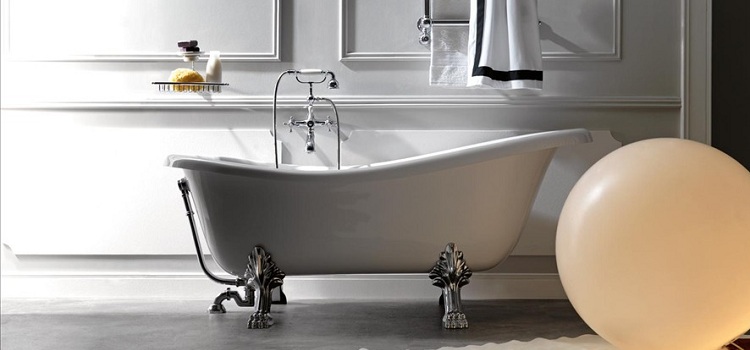
The bath siphon has the same operating principle as the sink, but can vary significantly in shape and size.
Content
Features of siphons for bathtubs
Unlike siphons, which are mounted on other plumbing equipment, bath devices have an additional overflow hole. It fits with the overall design to the level of the water seal. This arrangement provides isolation from the main sewer communication. In addition, this design allows you to remove excess water with a closed central channel.
Regardless of the design features, the overflow bath siphon performs two main functions:
- removal of water from the bathroom into the sewer system;
- prevention of penetration into the bathroom of odors from the drain pipes.
Note! The curved design of the bath siphon provides a water trap that prevents the entry of unpleasant odors from the sewer system into the house. The people call the bent siphon pipe “knee”. Such a pipe constantly contains a certain amount of water, which is an obstacle to sewer gases.
There are siphons, the design of which does not provide for the presence of a knee. Experts do not recommend purchasing such devices so as not to encounter problems in the future.
Materials of manufacture
The modern market boasts a variety of siphons for the material of manufacture. Consider the main ones:
- polypropylene (PP);
- polyvinyl chloride (PVC);
- alloy of copper and brass;
- steel.
Thus, all devices can be divided into:
- plastic;
- metal.
When choosing a plastic fixture, it is recommended that the material be durable. It is advisable that the parts of the plastic siphon that are in sight be chrome plated.
Metal siphons are less popular than plastic ones, however, they are highly durable and last quite a long time. Most often, copper-brass devices are used. They are characterized by rather high operational characteristics and are resistant to corrosive influences, which is a very important property for devices in contact with the aquatic environment. But their cost is slightly higher than their plastic counterparts.
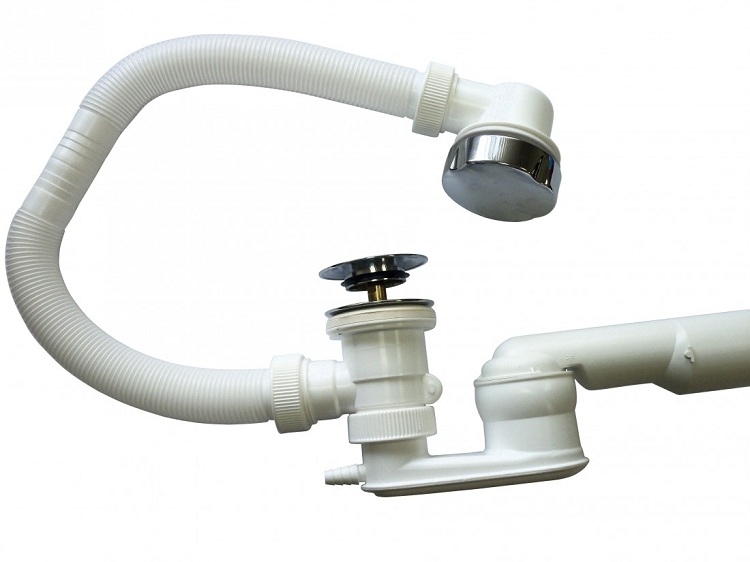
Plastic siphons are the simplest and most affordable, but their service life is shorter than that of metal models
Siphon device for bath
Water is discharged due to the correct arrangement of the siphon. Such a device consists of two main parts:
- drain block;
- overflow block.
Both of these blocks are pipelines.The drain block directly removes water from the bath to the sewer, and the overflow block does not allow water to overflow over the edge of the bath. The first block is fixed on the bottom of the bathtub, and the second - on the side (below the edge).
The entire structure for water drainage can be divided into 4 main parts:
- neck;
- knee;
- overflow corrugated hose;
- flexible tubes (soft or hard).
The neck is mounted on the bottom of the bath. Installation is carried out using a special metal screw that tightly tightens the external and internal elements. The required tightness indicators are achieved with rubber o-rings.
The knee, as mentioned above, has a curved design and provides a water seal in the system. The amount of water that is in the knee, as a rule, is 300-400 ml. This volume is enough to provide reliable protection for the bathroom from sewer gases.
The overflow hose belongs to the overflow unit and removes excess water from the bath. This eliminates the overflow of water over the edge of the bath. Water enters the overflow hose in small jets, so the use of a crimp design in this case is not necessary.
Helpful information! Siphons are equipped with flexible tubes that are connected to the sewer. In some cases, such tubes may be corrugated. Regardless of the type, they all have one very important property - the ability to adjust the length.
All bath siphons can be classified according to several main indicators:
- by design;
- by the method of water discharge;
- by manufacturer.
Types of siphons depending on the design
Depending on the design, the following varieties of these products exist.
Flat. The design of such a device allows their installation in a limited space. The main part of the device, in which a water shutter is formed and garbage accumulation occurs, is located horizontally. In order to clean the flat bath siphon, it is necessary to partially dismantle it.
Trumpet. Such devices are made of different lengths of pipe segments joined in a certain sequence. Pipes in this design have sufficient rigidity. Such a bathroom siphon is more compact than the previous type, however, due to the lack of a compartment in which garbage is concentrated, its cleaning is more difficult.
Bottle. This view is distinguished by the presence of a special compartment, which in shape resembles a bottle (hence the name). Garbage is collected in this compartment, and a water lock is located in it. Bottle siphons differ in rather large dimensions in comparison with other types, therefore their installation is possible only if there is enough free space under the bathtub. Such devices can be periodically cleaned without a complete analysis of the design, which is very convenient.
Corrugated. They differ in the simplest design, which includes a drain-overflow device and a soft pipe. The pipe is able to bend in any necessary direction. Corrugated siphon for a bath has one drawback - rapid clogging. This is due to the fact that the ribbed walls trap foreign particles. In addition, connecting the overflow element often causes difficulties.
Varieties of siphons by water discharge method
There are the following varieties of siphons according to the method of water discharge:
- hand held;
- semi-automatic;
- automatic.
Tame. The design of such devices is considered the simplest. These devices are equipped with a drain hole, which is manually adjustable (opens and closes).
Semi-automatic. Semi-automatic devices at the manufacturing stage are equipped with a special cork with an additional cable. The adjustment of such a plug is carried out by means of a handle located outside the bathtub. As a rule, such a handle has two positions: directly draining the water from the bathtub or loading the overflow hole.
Automatic (click-clack devices). Such devices are the most complex in terms of performance. The bath machine is capable of regulating the water level in the bathtub itself. In order to drain the water, in this case, you just need to press the drain cover.
Important! Experts do not recommend installing automatic models on their own. This is due to the fact that their installation requires special knowledge and high accuracy, otherwise such a system will be incapable.
How to choose a siphon for a bath?
Consider the basic rules for choosing a siphon for a bath:
- The connecting diameter of the pipe of the sewer system, as a rule, is 32, 40 or 50 mm. Before buying a siphon for a bath, it is necessary to measure the cross-section of the old drain. If a device of a suitable size was not found, you can buy a special transitional cuff, which will allow you to connect the siphon to the sewer pipe.
- When choosing a siphon, it is very important to remember that the device must be sized for the bath. Especially this item must be taken into account if the container was made to order. Such bathtubs may not always fit standard equipment. Therefore, before purchasing such a device, it is desirable to measure the diameter of the drain holes in advance, and also to determine the distance from the drain to the overflow.
- It must be remembered that the installation of the siphon should not be too tight. In the event that the space under the bath is limited, a more compact device is installed.
- Installation of a siphon is a necessity not only for a bath, but also for a wash basin, as well as a washing machine and any other plumbing equipment. In order not to engage in the installation of several devices, experts recommend choosing a siphon, which has additional inlets. With this model, you can connect all the necessary devices.
- An important criterion when choosing such a device is its cost. If your budget is limited, then inexpensive plastic models are best. The most reliable products are considered to be from German and Swiss manufacturers, however, the cost of such siphons is corresponding.
- Together with the siphon, all the necessary details for its installation should be included. The product should not have any visual defects, since any dent or chip will subsequently affect its operational properties.
The choice of siphon must be approached with all seriousness and pay attention to all of the above items.
Installing a new siphon
Before installing the siphon on the bath, it is necessary to dismantle the old device. Removing an old plastic device, as a rule, does not cause any difficulties. If the nuts are too tightly tightened or “stuck” from time to time, you can simply remove the structure in parts, sawing it.
Important! In order to dismantle the metal structure, the following tools will be required: grinder, hammer, chisel. The work must be done very carefully so as not to damage the bath.
After the dismantling is completed, you can proceed with the installation of a new siphon.But first, you need to pay attention to a few useful tips that will help simplify the installation of this device:
- It is not recommended to assemble the main parts of the siphon under the bathtub, as there is quite limited space there. It is advisable to assemble all the necessary main parts before installation;
- When installing the cone gasket, you need to make sure that it is laid on the right side. The wide side of the gasket should be in the direction of the nut.
- it is advisable to tighten the coupling nuts without using a wrench, as this may cause cracks. Using keys very often leads to pulling, so the best option would be to tighten them by hand.
Consider the sequence of installation work:
- First of all, it is necessary to mount a decorative grille with a gasket.
- Further, on the other side of the bath, it is necessary to press the outlet pipe, which is also equipped with a special gasket.
- Then you need to fix the pipe. This work is done by screwing the screw into the previously installed grille.
- It is necessary to assemble the siphon elbow into which the outlet pipe will be installed.
- It is necessary to bring the adapter, which is necessary for the connection of the pipe.
- The outlet responsible for overflow is mounted to the overflow hole.
- The final step involves checking the mounted structure. Installation can be considered successful if there is no leakage anywhere.
In addition, it is recommended that you carefully study the instructions that accompany it before installing this device yourself. Such an instruction should contain a detailed diagram for mounting the siphon.
